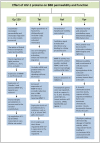Effect of human immunodeficiency virus on blood-brain barrier integrity and function: an update
- PMID: 26113810
- PMCID: PMC4461820
- DOI: 10.3389/fncel.2015.00212
Effect of human immunodeficiency virus on blood-brain barrier integrity and function: an update
Abstract
The blood-brain barrier (BBB) is a diffusion barrier that has an important role in maintaining a precisely regulated microenvironment protecting the neural tissue from infectious agents and toxins in the circulating system. Compromised BBB integrity plays a major role in the pathogenesis of retroviral associated neurological diseases. Human Immunodeficiency Virus (HIV) infection in the Central Nervous System (CNS) is an early event even before the serodiagnosis for HIV positivity or the initiation of antiretroviral therapy (ART), resulting in neurological complications in many of the infected patients. Macrophages, microglia and astrocytes (in low levels) are the most productively/latently infected cell types within the CNS. In this brief review, we have discussed about the effect of HIV infection and viral proteins on the integrity and function of BBB, which may contribute to the progression of HIV associated neurocognitive disorders.
Keywords: HIV; Nef; Tat; Vpr; blood-brain barrier; gp120; neurocognitive disorders.
Figures
Similar articles
-
Human immunodeficiency virus infection of human astrocytes disrupts blood-brain barrier integrity by a gap junction-dependent mechanism.J Neurosci. 2011 Jun 29;31(26):9456-65. doi: 10.1523/JNEUROSCI.1460-11.2011. J Neurosci. 2011. PMID: 21715610 Free PMC article.
-
Breaking down the barrier: the effects of HIV-1 on the blood-brain barrier.Brain Res. 2011 Jul 5;1399:96-115. doi: 10.1016/j.brainres.2011.05.015. Epub 2011 May 14. Brain Res. 2011. PMID: 21641584 Free PMC article. Review.
-
Protective Effects of Ginsenoside Rb1 against Blood-Brain Barrier Damage Induced by Human Immunodeficiency Virus-1 Tat Protein and Methamphetamine in Sprague-Dawley Rats.Am J Chin Med. 2018;46(3):551-566. doi: 10.1142/S0192415X18500283. Am J Chin Med. 2018. PMID: 29690789
-
Brain Macrophages in Simian Immunodeficiency Virus-Infected, Antiretroviral-Suppressed Macaques: a Functional Latent Reservoir.mBio. 2017 Aug 15;8(4):e01186-17. doi: 10.1128/mBio.01186-17. mBio. 2017. PMID: 28811349 Free PMC article.
-
Interaction between Tat and Drugs of Abuse during HIV-1 Infection and Central Nervous System Disease.Front Microbiol. 2016 Jan 11;6:1512. doi: 10.3389/fmicb.2015.01512. eCollection 2015. Front Microbiol. 2016. PMID: 26793168 Free PMC article. Review.
Cited by
-
Current status of non-viral gene therapy for CNS disorders.Expert Opin Drug Deliv. 2016 Oct;13(10):1433-45. doi: 10.1080/17425247.2016.1188802. Epub 2016 Jun 1. Expert Opin Drug Deliv. 2016. PMID: 27249310 Free PMC article. Review.
-
Electro-Magnetic Nano-Particle Bound Beclin1 siRNA Crosses the Blood-Brain Barrier to Attenuate the Inflammatory Effects of HIV-1 Infection in Vitro.J Neuroimmune Pharmacol. 2017 Mar;12(1):120-132. doi: 10.1007/s11481-016-9688-3. Epub 2016 Jun 10. J Neuroimmune Pharmacol. 2017. PMID: 27287620 Free PMC article.
-
Polypharmacy, Hazardous Alcohol and Illicit Substance Use, and Serious Falls Among PLWH and Uninfected Comparators.J Acquir Immune Defic Syndr. 2019 Nov 1;82(3):305-313. doi: 10.1097/QAI.0000000000002130. J Acquir Immune Defic Syndr. 2019. PMID: 31339866 Free PMC article.
-
Vascular cognitive impairment and HIV-associated neurocognitive disorder: a new paradigm.J Neurovirol. 2019 Oct;25(5):710-721. doi: 10.1007/s13365-018-0706-5. Epub 2019 Jan 11. J Neurovirol. 2019. PMID: 30635846 Review.
-
HIV induces production of IL-18 from intestinal epithelial cells that increases intestinal permeability and microbial translocation.PLoS One. 2018 Mar 30;13(3):e0194185. doi: 10.1371/journal.pone.0194185. eCollection 2018. PLoS One. 2018. PMID: 29601578 Free PMC article.
References
-
- Acheampong E. A., Parveen Z., Muthoga L. W., Kalayeh M., Mukhtar M., Pomerantz R. J. (2005). Human immunodeficiency virus type 1 Nef potently induces apoptosis in primary human brain microvascular endothelial cells via the activation of caspases. J. Virol. 79, 4257–4269. 10.1128/jvi.79.7.4257-4269.2005 - DOI - PMC - PubMed
-
- Anthony I. C., Ramage S. N., Carnie F. W., Simmonds P., Bell J. E. (2005). Influence of HAART on HIV-related CNS disease and neuroinflammation. J. Neuropathol. Exp. Neurol. 64, 529–536. - PubMed
Publication types
Grants and funding
LinkOut - more resources
Full Text Sources
Other Literature Sources



